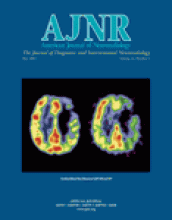Abstract
BACKGROUND AND PURPOSE: Theoretically, proton (1H) MR spectroscopy at a higher field strength has the advantages of higher signal-to-noise ratio and improved spectral resolution. We therefore compared the ability of single-voxel 1H MR spectroscopy at 1.5 and 3 T to diagnostically discriminate among cognitively normal elderly subjects, patients with mild cognitive impairment (MCI), and patients with Alzheimer disease (AD).
METHODS: At both 1.5 and 3 T, we studied 41 cognitively normal elderly subjects, 20 patients with MCI, and 20 patients with AD. In each subject, 1H MR spectroscopy was performed at TEs of 30 and 135 ms and from voxels placed over the posterior cingulate gyri.
RESULTS: Average line widths and interexamination variability of metabolite ratios were higher at 3 T than at 1.5 T. Consistent quantification of glutamine (Gln) + glutamate/creatine (Cr) and Gln/Cr peak ratios occurred at 3 T but not at 1.5 T. Choline (Cho)/Cr (at TE = 135 ms) and myo-inositol (MI)/Cr were higher and N-acetylaspartate (NAA)/Cr (at TE = 135 ms) and NAA/MI were lower in patients with MCI than in cognitively normal subjects only at 1.5 T. MI/Cr and Cho/Cr were higher and NAA/Cr and NAA/MI were lower in patients with AD than in cognitively normal subjects at both 1.5 and 3 T. Differentiation of patients with AD from cognitively normal subjects by using the NAA/MI data was similar at both field strengths (P > .05).
CONCLUSION: With currently available technology, the diagnostic performance of 1H MR spectroscopy in patients with MCI and those with AD was not better at 3 T than at 1.5 T.
- Copyright © American Society of Neuroradiology












